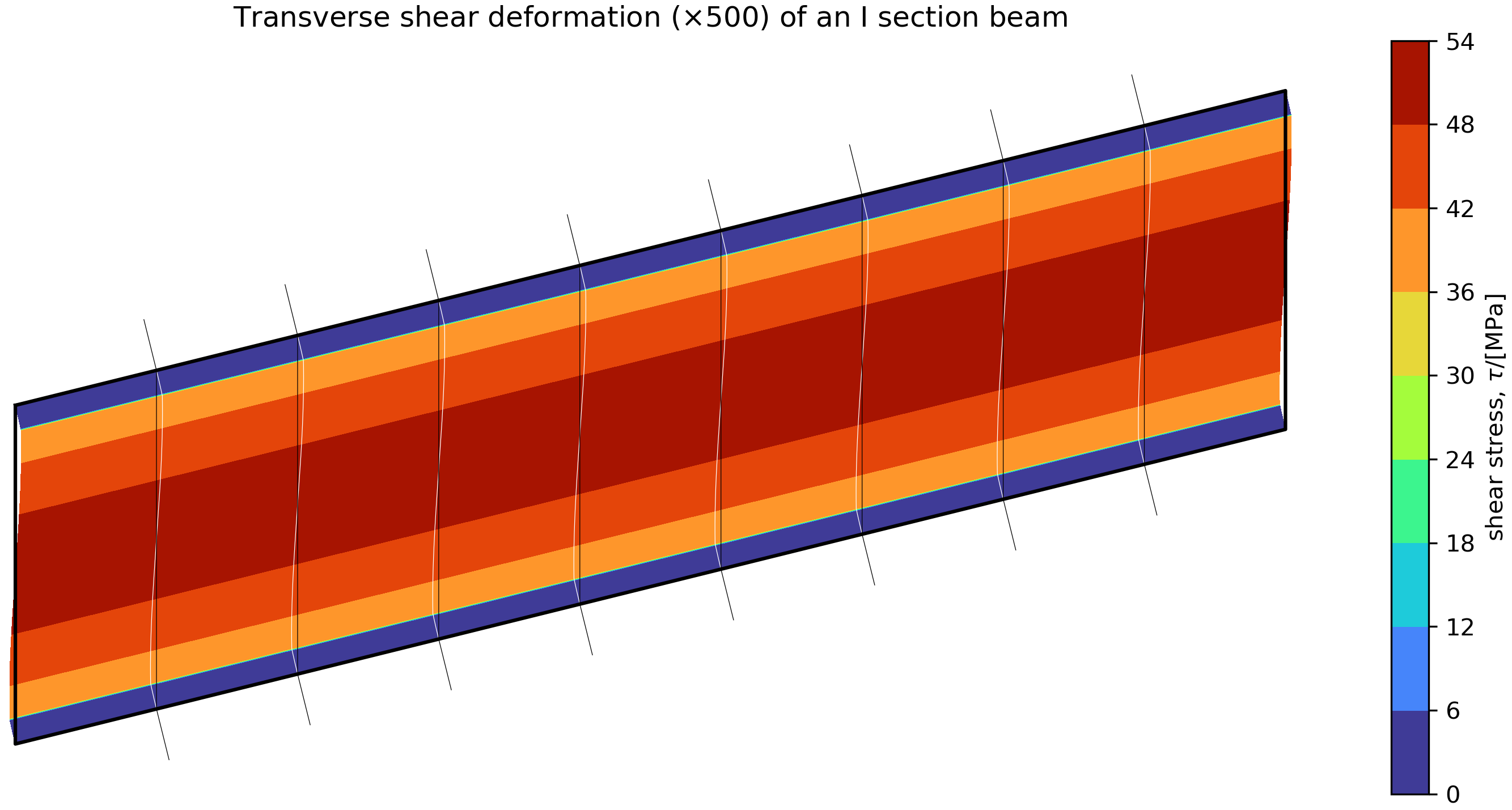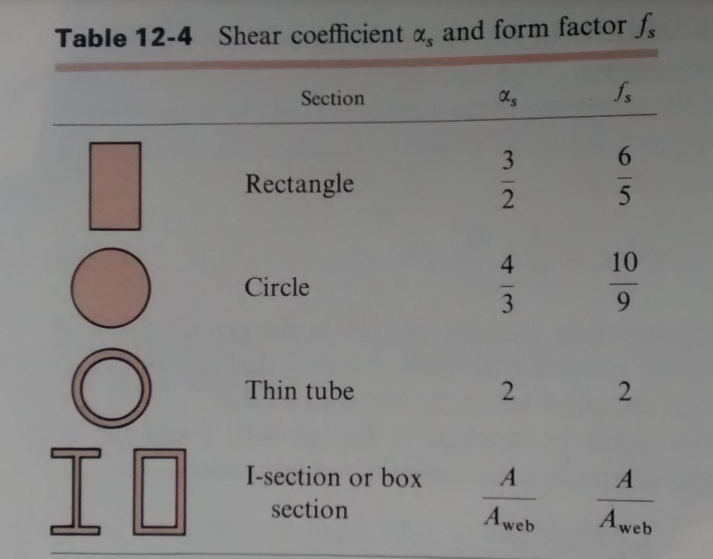I’m trying to analyze the bending of an I beam using the Timoshenko beam equation and I can’t seem to find the value for the shear coefficient anywhere. Surely someone must’ve done the work (given how common I-beams are in structural engineering) and has a value or table of values. Or are there any algebraic (empirical) equations I can solve to get the values ? Thanks !
3 Answers
On top of flexural deflection, the Timoshenko Beam Theory includes a term called "Shear Deformation" that is to account for the additional deflection and shear stress due to shear effect, which is quite samall compared to the effect from the flexural, thus it is usually ignored except higher accuracy is desired. (See figure below)
The slope of the deflection curve of the beam due to shear alone is approximately equal to the shear strain at the neutral axis. Thus denoting by $v_s$ the deflection due to shear alone can be evaluated through the expression for the slope:
$$\dfrac{\text{d}v_s}{\text{d}x} = r_c = \dfrac{\alpha_sV}{GA}$$
In which the $\alpha_s$ is called "shear coefficient" by which the average shear stress ($V/A$) must be multiplied to obtain the shear stress at the centroid of the cross-section. The shear coefficient for a rectangle cross-section is 3/2 (isn't it familiar?) and is 4/3 for a circular cross-section.
However, shear deflection obtained by solving the equation using the unit load method is considered an approximation for two reasons:
- The deflections are based upon the shear strain at the neutral axis, hence, they do not take into account the variation in shear strains throughout the height of the beam.
- The deflections are based upon a bending theory derived for the case of "pure bending" only.
The second defect can be remedied only by the more exact methods of the theory of elasticity, whereas the first can be eliminated by using the principle of virtual work, which is expressed as:
$$W_v = \int \dfrac{V_v V_L}{GI^2} \left[\int \dfrac{Q^2}{b^2} \text{d}y \text{d}z\right] \text{d}x$$
To simplify the expression, a cross-sectional property was introduced:
$$\begin{align} f_s &= \dfrac{A}{I^2} \int \dfrac{Q^2}{b^2} \text{d}A \\ \therefore W_v &= \dfrac{1}{GA} \int f_sV_vV_L dx = \delta_s \end{align}$$
$f_s$ is called the "form factor" for shear. The form factor is a dimensionless quantity that can be evaluated for the particular shape of the beam. It is 6/5 for a rectangle cross-section, and 10/9 for a solid round beam.
Here is a table of the shear coefficient and shear factor for a few typical cross-sections.
Reference: "Mechanics of Materials", 2nd, Gere & Timoshenko. CH 7 & CH 12.
-
$\begingroup$ Excellent answer, +1. However, could you edit your equations to use MathJax, to make them easier to read? I tried doing the edit myself, but am not used to this notation (are those asterisks for multiplication or superscripts? Is $⌠$ meant to be an integral?) and didn't want to get it wrong. $\endgroup$– WasabiCommented Apr 19, 2021 at 20:43
-
$\begingroup$ @Wasabi Can you help? I've got a hard time with that editor. Thanks. $\endgroup$– r13Commented Apr 19, 2021 at 20:50
-
1$\begingroup$ If you follow the link in my first comment, it's a good intro to MathJax. But basically, just wrap your equations in dollar signs to turn them into MathJax. If you want to do fractions, use
\dfrac{numerator}{denominator}. If you want to show an integral, just use\int x. For sub/superscripts, usex_{sub}andx^{super}. For symbols, you can usually just put a backslash before the name such as\alpha. As a full example$\int \dfrac{\alpha^{2z}}{5y_{2z}}$= $\int \dfrac{\alpha^{2z}}{5y_{2z}}$ $\endgroup$– WasabiCommented Apr 19, 2021 at 20:59 -
1$\begingroup$ Good answer, but beware that if you are using software to model a beam structure, some programs use the reciprocal of the form factor defined in the answer - i.e. check if the correct input value for a rectangular beam is 5/6 or 6/5. $\endgroup$ Commented Apr 19, 2021 at 22:09
-
1$\begingroup$ @r13: Good job with the MathJax! I made a few changes, but what you did was already very beneficial! $\endgroup$– WasabiCommented Apr 19, 2021 at 23:52
Usually $\kappa = \dfrac{\text{average shear strain on section}}{\text{shear strain at centroid}}$ but the problem with this definition is that it depends on external loading so you can't actually make a table for $\kappa$ values. However, we could make an assumption and define $\kappa$ purely in terms of the shape of the section: $\kappa_i = \frac{1}{\alpha_i}$. Then we can calculate from this expression:
$$\begin{align} \alpha_y &= \dfrac{A}{Q_y}\left[\dfrac{A_{\varphi\bar{y}}A_{\bar{z}\bar{z}} - A_{\varphi\bar{z}}A_{\bar{y}\bar{z}}}{A_{\bar{y}\bar{y}}A_{\bar{z}\bar{z}} - A^2_{\bar{y}\bar{z}}} + \dfrac{\nu}{2(1+\nu)}\dfrac{C_{zz}A_{\bar{z}\bar{z}} - C_{yy}A_{\bar{y}\bar{z}}}{A_{\bar{y}\bar{y}}A_{\bar{z}\bar{z}} - A^2_{\bar{y}\bar{z}}}\right] \\ \alpha_z &= \dfrac{A}{Q_z}\left[\dfrac{A_{\varphi\bar{z}}A_{\bar{y}\bar{y}} - A_{\varphi\bar{y}}A_{\bar{y}\bar{z}}}{A_{\bar{y}\bar{y}}A_{\bar{z}\bar{z}} - A^2_{\bar{y}\bar{z}}} + \dfrac{\nu}{2(1+\nu)}\dfrac{C_{yy}A_{\bar{y}\bar{y}} - C_{zz}A_{\bar{y}\bar{z}}}{A_{\bar{y}\bar{y}}A_{\bar{z}\bar{z}} - A^2_{\bar{y}\bar{z}}}\right] \end{align}$$
I won't go into details of the terms such as $C_{ij}$ and $A_{ij}$. You could find details for it in this document Shear correction factors in Timoshenko’sbeam theory for arbitrarily shaped cross–sections. They also made a program for the calculation of $\alpha_i$. Read the document if you have any problem, hit me up.
For a I beam with parameters:
- height $h$ (z axis)
- width $w$ (y axis)
- flange thickness $t$
- web thickness $s$
Timoshenko shear coefficient should be $$\kappa_y = \frac{J_y h}{2A\left(\frac{3ht^2-2t^3}{12} + \frac{wt}{2s}(h-t)(h/2-t)+\frac{(h/2-t)^3}{3}\right)}$$
where $J_y$ the second moment of area to axis y and $A$ is the section area.
Background
You can derive shear stress from Zhuravskii formula. From that, you can get local shear deformation across the transverse coordinate of the section: $$\gamma(z) = \frac{\tau(z)}{G}$$ Since the shear stress is zero at top and bottom surface, the points there should have the same axial deflection, which in case of just the shear loading should be zero. You can get the angle of deformation $$\varphi=\frac{T}{\kappa_y G A}$$ from this condition (it is similar to average shear strain but just across the transverse coordinate, not the weighted average): $$\int\limits_{-h/2}^{h/2}\varphi-\gamma(z) dz = 0$$ and transform it into the shear coefficient $\kappa_y$: $$\kappa_y=\frac{T}{\varphi G A}$$
You can see the deformation just from the transverse shear stress in the following figure:

What is relation of this $\kappa_y$ coefficient with $A_w/A$? As you can see in the figure, the coefficients are similar for I sections with thin webs and flanges, but $\kappa$ is higher than $A_w/A$ for thicker webs and flanges.



